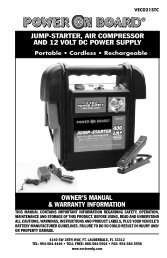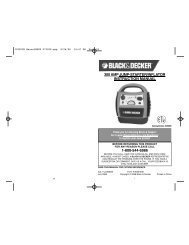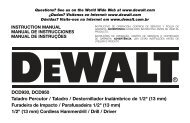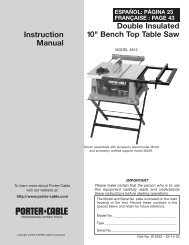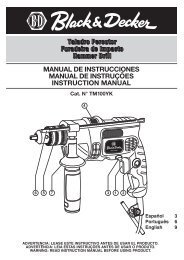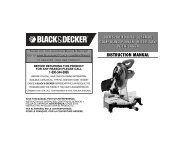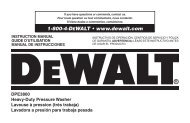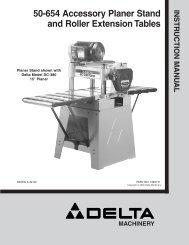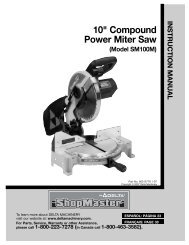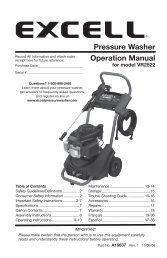3680 12" Compound Miter Saw Instruction Manual
3680 12" Compound Miter Saw Instruction Manual
3680 12" Compound Miter Saw Instruction Manual
- No tags were found...
Create successful ePaper yourself
Turn your PDF publications into a flip-book with our unique Google optimized e-Paper software.
TM<strong>Instruction</strong> <strong>Manual</strong><strong>3680</strong> 12" <strong>Compound</strong> <strong>Miter</strong> <strong>Saw</strong>
Getting the most out of your tool.Please take time to read this manual and pay particular attention to the safety rules we’ve provided foryour protection. Don’t forget to send in your owner’s registration card. If you have any questionsabout your tool please call:1-800-9-BD TOOL(1-800-923-8665)TRIGGER SWITCHOPERATING HANDLECARRYING HANDLEREAR LOWER GUARDGUARDSPINDLE LOCK BUTTONBRUSH INSPECTION CAPLOCK DOWN PINRIGHT SIDEFENCEREAR LOWER GUARDLEFT SIDE OF FENCEMOTOR HOUSINGBEVEL STOPLEFT SIDE FENCECLAMPINGKNOBSMITER CLAMP KNOBMITER CLAMPKNOBDUST SPOUTBEVEL CLAMPKNOBBLADE WRENCHBENCHMOUNTINGHOLESMITER LATCHMITER SCALEMITER LATCHMITER SCALEBEVEL SCALEHAND INDENTATION
Table of ContentsSAFETY INSTRUCTIONS..............................................................................................1ADDITIONAL SAFETY RULES......................................................................................2ELECTRICAL CONNECTION.........................................................................................2GROUNDING INSTRUCTIONS .....................................................................................2EXTENSION CORDS.....................................................................................................3UNPACKING YOUR SAW.............................................................................................3FAMILIARIZATION.......................................................................................................3SPECIFICATIONS.........................................................................................................3BENCH MOUNTING .....................................................................................................3INSTALLING THE BLADE.............................................................................................4REAR LOWER GUARD ADJUSTMENT.........................................................................4CUTTING THE KERF.....................................................................................................4TRANSPORTING THE SAW .........................................................................................4ADJUSTMENTS ...........................................................................................................4MITER SCALE ADJUSTMENT......................................................................................4MITER POINTER ADJUSTMENT..................................................................................5BEVEL STOP ADJUSTMENT........................................................................................5FENCE ADJUSTMENT ..................................................................................................5GUARD ACTUATION AND VISIBILITY .........................................................................5AUTOMATIC ELECTRIC BRAKE ...................................................................................6SWITCH .......................................................................................................................6CUTTING WITH YOUR SAW ........................................................................................6CROSSCUTS................................................................................................................6BEVEL CUTS ................................................................................................................6QUALITY OF CUT .........................................................................................................6BODY AND HAND POSITION .......................................................................................7CLAMPING THE WORKPIECE......................................................................................7SUPPORT FOR LONG PIECES .....................................................................................7CUTTING PICTURE FRAMES, SHADOW BOXES .........................................................7AND OTHER FOUR SIDED PROJECTSCUTTING TRIM MOLDING AND OTHER FRAMES .......................................................7CUTTING COMPOUND MITERS ..............................................................................7DUAL RANGE MITER SCALE...................................................................................8VERNIER SCALE .....................................................................................................8CUTTING BASEBOARD MOLDINGS ............................................................................9CUTTING CROWN MOLDING ......................................................................................10TROUBLE SHOOTING TIPS .........................................................................................11MAINTENANCE ............................................................................................................12ACCESSORIES.............................................................................................................12FOR YOUR SAFETY - ALL TOOLSWARNING: When using Electric Tools, basic safety precautions should always be followed to reducethe risk of fire, shock, and personal injury, including the following:READ ALL INSTRUCTIONS1. KEEP GUARDS IN PLACE and in working order.2. REMOVE ADJUSTING KEYS AND WRENCHES. Form habit of checking to see that keys andadjusting wrenches are removed from tool before turning it on.3. KEEP WORK AREA CLEAN. Cluttered areas and benches invite accidents.4. DON’T USE IN DANGEROUS ENVIRONMENT. Don’t use power tools in damp or wet locations, orexpose them to rain. Keep work area well lighted.5. KEEP CHILDREN AWAY. All visitors should be kept at a safe distance from work area.6. MAKE WORKSHOP KID PROOF with padlocks, master switches, or by removing starter keys.7. DON’T FORCE TOOL. It will do the job better and be safer at the rate for which it was designed.8. USE RIGHT TOOL. Don’t force tool or attachment to do a job for which it was not designed.9. WEAR PROPER APPAREL. No loose clothing, gloves, neckties, rings, bracelets, or other jewelryto get caught in moving parts. Nonslip footwear is recommended. Wear protective hair coveringto contain long hair.10. ALWAYS WEAR SAFETY GLASSES. Also use face or dust mask if cutting operation is dusty.Everyday eyeglasses have only impact resistant lenses. They are NOT safety glasses.11. SECURE WORK. Use clamps or vise to hold work when practical. It’s safer than using your handand it frees both hands to operate tool.12. DON’T OVERREACH. Keep proper footing and balance at all times.13. MAINTAIN TOOLS WITH CARE. Keep tools sharp and clean for best and safest performance.Follow instructions for lubricating and changing accessories.14. DISCONNECT TOOLS before servicing; when changing accessories such as blades, bits, cutters,etc.15. REDUCE THE RISK OF UNINTENTIONAL STARTING. Make sure switch is in OFF position beforeplugging in.16. USE RECOMMENDED ACCESSORIES. Consult the instruction manual for recommended accessories.The use of improper accessories may cause risk of injury to persons.17. NEVER STAND ON TOOL. Serious injury could occur if the tool is tipped or if the cutting tool isunintentionally contacted.18. CHECK DAMAGED PARTS. Before further use of the tool, a guard or other part that is damagedshould be carefully checked to determine that it will operate properly and perform its intendedfunction—check for alignment of moving parts, binding of moving parts, breakage of parts,mounting and any other conditions that may affect its operation. A guard or other part that isdamaged should be properly repaired or replaced.19. NEVER LEAVE TOOL RUNNING UNATTENDED. TURN POWER OFF. Don’t leave tool until itcomes to a complete stop.20. DO NOT OPERATE ELECTRIC TOOLS NEAR FLAMMABLE LIQUIDS OR IN GASEOUS OR EXPLO-SIVE ATMOSPHERES. Motors in these tools may spark and ignite fumes.1
sketch B if a properly grounded outlet is not available. The temporary adapter should be used onlyuntil a properly grounded outlet can be installed by a qualified electrician. The green-colored rigid ear,lug, and the like, extending from the adapter must be connected to a permanent ground such as aproperly grounded outlet box.ADAPTER SHOWN IN FIGURES B & C IS NOT FOR USE IN CANADA.Extension CordsTools that have 3 wire cords requiring grounding must only be used with extension cords that have 3-prong grounding type plugs and 3-pole receptacles. Only round jacketed extension cords should beused, and we recommend that they be listed by Underwriters Laboratories (U.L.) (C.S.A. in Canada). Ifthe extension will be used outside, the cord must be suitable for outdoor use. The letters “WA” on thecord jacket indicate that it is suitable for outdoor use. Any cord marked as outdoor can also be usedfor indoor work.An extension cord must have adequate wire size (AWG or American Wire Gauge) for safety, and toprevent loss of power and overheating. The smaller the gauge number of the wire, the greater thecapacity of the cable, that is 16 gauge has more capacity than 18 gauge. When using more than oneextension to make up the total length, be sure each individual extension contains at least the minimumwire size. To determine the minimum wire size required, refer to the following chart:120 VOLT TOOLS: CHART FOR MINIMUM WIRE SIZE (AWG) OF EXTENSION CORDSCord Length (feet) 25 50 75 100Guage: 16 14 12 10Before using an extension cord, inspect it for loose or exposed wires, damaged insulation, anddefective fittings. Make any needed repairs or replace the cord if necessary. B&D has extensioncords available that are U.L. (C.S.A. in Canada) listed for outdoor use.Unpacking Your <strong>Saw</strong>Check the contents of your miter saw carton to make sure that you have received all parts. In additionto this instruction manual, the carton should contain: one <strong>3680</strong> miter saw, one carbide saw bladeand one blade wrench in wrench pocket.FamiliarizationYour miter saw is fully assembled in the carton. Open the box and lift the saw out by the convenientcarrying handle, as shown in Figure 1. Place the saw on a smooth, flat surface such as a workbench orstrong table. Examine Figures on inside front cover of this manual to become familiar with the sawand its various parts. The following section on adjustmentswill refer to these terms and you must know whatthe parts are.Press down lightly on the operating handle and pull outthe lock down pin, as shown in Figure 2. Gently releasethe downward pressure and allow the arm to rise to itsfull height. Use the lock down pin when carrying the sawfrom one place to another. Always use the carrying handleor the hand indentations to transport the saw.Figure 13SpecificationsCapacity of cut48˚ miter left and right0˚ miter48˚ bevel left: 3˚ right Max. Height 3.9" Result Width 5.9"Max. Width 7.9" Result Height 2.5"45˚ miter45˚ bevelMax. Height 3.9" Result Width 4.1" Max. Height 2.7” Result Width 5.9”Max. Width 5.5" Result Height 2.5" Max Width 7.9” Result Height 1.7”Drive2000 Watts out 13 Amp MotorCut Helical Gears with Ball BearingsCarbide Blade, 4000 RPMAutomatic Electric BrakeBench MountingHoles are provided in all four feet to facilitate bench mounting. (Two different sized holes are providedto accommodate different sizes of screws. Use either hole, it is not necessary to use both.) Alwaysmount your saw firmly to prevent movement. To enhance the tool’s portability, it can be mounted to apiece of 1/2” or thicker plywood which can then be clamped to your work support or moved to otherjob sites and reclamped.NOTE: If you elect to mount your saw to a piece of plywood, make sure that the mounting screwsdon’t protrude from the bottom of the wood. The plywood must sit flush on the work support. Whenclamping the saw to any work surface, clamp only on the clamping bosses where the mounting screwholes are located. Clamping at any other point will surely interfere with the proper operation of thesaw.CAUTION: To prevent binding and inaccuracy, be sure the mounting surface is not warped or otherwiseuneven. If the saw rocks on the surface, place a thin piece of material under one saw foot untilthe saw sits firmly on the mounting surface.Figure 2 Figure 3LOCK DOWNPINADJUSTMENT AND SET UPGUARD BRACKETSCREW
Installing the BladeTURN OFF TOOL AND DISCONNECT FROM POWER SUPPLY.DO NOT CUT FERROUS METAL (THAT WITH AN IRON OR STEEL CONTENT) OR MASONRY WITHTHIS MITER SAW.1. With the saw arm in the upper position, raise the lower guard as far as possible.2. Loosen (but do not remove) the guard bracket screw, shown in Figure 3 until the guard bracket canbe raised enough to permit access to the blade screw.3. Hold the lower guard up and depress the spindle lock button with one hand and use the suppliedblade wrench in the other hand to loosen (clockwise) the left hand threaded blade screw. NOTE: Touse the spindle lock, depress the button as shown and rotate the spindle by hand until you feel thelock engage. Continue to hold the lock button in to keep the spindle from turning.4. Install the saw blade making sure that the teeth at the bottom edge of the blade are pointing towardthe back of the saw (away from the operator).5. Replace the outer blade washer and tighten the blade screw (counterclockwise) while holding thelower guard up and the spindle lock engaged with your other hand.NEVER DEPRESS THE SPINDLE LOCK BUTTON WHILE THE BLADE IS ROTATING.AFTER INSTALLING THE SAW BLADE, REPOSITION GUARD BRACKET MAKING SURE IT IS FULLYSEATED ON GUARD SCREW. FIRMLY TIGHTEN SCREW. FAILURE TO DO SO WILL CAUSE SERIOUSDAMAGE TO THE SAW.Rear Lower Guard AdjustmentCheck the rear lower guard to ensure that it is located such that the saw blade is in the center andequidistant from each side, as shown in Figures 4 & 5. Adjust as necessary by loosening the twoscrews and moving the guard. Firmly tighten both screws. Never remove this guard.Cutting the KerfIn order to adjust and use your miter saw, you must cut a slot through the kerf plate to allow for bladeclearance. To cut the kerf plate:Transporting the <strong>Saw</strong>TURN OFF TOOL AND DISCONNECT FROM POWER SUPPLY.In order to conveniently carry the miter saw from place to place, a carrying handle has been includedon the top of the saw arm. To transport the saw, lower the arm and depress the lock down pin shownin Figure 2.NOTE: The saw arm cannot be fully lowered if the tool has a blade installed unless the kerf plate hasbeen cut. If you wish to transport the saw before cutting the kerf plate, remove the saw blade.AdjustmentsPERFORM ALL ADJUSTMENTS WITH THE MITER SAW UNPLUGGED!NOTE: Your miter saw is fully and accurately adjusted at the factory at the time of manufacture. Ifreadjustment due to shipping and handling or any other reason is required, follow the steps below toadjust your saw. Once made, these adjustments should remain accurate. Take a little time now to followthese directions carefully to attain the accuracy of which your saw is capable.<strong>Miter</strong> Scale AdjustmentTURN OFF TOOL AND DISCONNECT FROM POWER SUPPLY.1. Place a square against the saw’s fence and blade, as shown in Figure 6. (Do not touch the tips ofthe blade teeth with the square. To do so will cause an inaccurate measurement.)2. Loosen the miter clamp knob (Figure 7) and swing the miter arm until the miter latch locks it at the0 miter position. Do not tighten the clamp knob.3. If the saw blade is not exactly perpendicular to the fence, loosen the three screws that hold themiter scale to the base (Figure 7) and move the scale/miter arm assembly left or right until theblade is perpendicular to the fence, as measured with the square.4. Retighten the three screws. Pay no attention to the reading of the miter pointer at this time.1. Set the saw at 0˚ miter.2. Place a piece of scrap wood on the kerf plate at least 1"x6"x12".3. Turn the saw on and allow the blade to reach full speed.4. Pull the saw arm down as far as it will go and CUT SLOWLY THROUGH THE SCRAP WOOD ANDTHE PLASTIC KERF PLATE.5. Turn the saw off and allow the blade to stop before raising the saw arm.6. Loosen and move the left side of the fence as far as it will go to the left.7. Now adjust the bevel angle to 45˚.8. Once again, turn on the saw and allow the blade to reach full speed.9. Pull the arm down and cut slowly through the wood and kerf plate again. (This procedure willwiden the kerf plate cut so that the blade will pass through it at any angle from 0˚ to 45˚).Be sure to adjust the left side of the fence so that it’s as close to the saw blade as possible withoutinterfering with arm up & down movement. Tighten the fence in position using both knobs. Don’t usewithout kerf plate or when kerf slot is wider than 3/8”.Figure 4SAW BLADEFigure 5OUTER CLAMPWASHERBLADESCREWDISTANCESFROM BLADEMUST BE EQUALINNER CLAMPWASHERREAR LOWERGUARDREAR LOWERGUARD4
1212Figure 16 Figure 17355531.623060259022.55858010KERF PLATE7012065252590Figure V122.5585555040 4522.54565112 2 118010Figure V245701225652512131.6260030555040 4ANGLE “A”MITER ARMNOTE: If the cutting angle varies from cut to cut, check that the bevel clamp knob and the miter lockknob are securely tightened. These knobs must be tightened after making any changes in bevel ormiter.The chart shown on page 10 will assist you in selecting the proper bevel and miter settings for commoncompound miter cuts. To use the chart, select the desired angle “A” (Figure 17) of your projectand locate that angle on the appropriate arc in the chart. From that point follow the chart straight downto find the correct bevel angle and straight across to find the correct miter angle.Set your saw to the prescribed angles and make a few trial cuts. Practice fitting the cut pieces togetheruntil you develop a feel for this procedure and feel comfortable with it.Example: To make a 4 sided box with 25° exterior angles (Angle A, Table 1), use the upper right arc.Find 25° on the arc scale. Follow the horizontal intersecting line to either side to get miter angle settingon saw (23°). Likewise, follow the vertical intersecting line to the top or bottom to get the bevel anglesetting on the saw (40°). Always try cuts on a few scrap pieces of wood to verify settings on saw.Dual Range <strong>Miter</strong> ScaleThe miter scale has two ranges of numbers for convenience,as shown in Figure 18. One scale indicates 0˚when the blade is square to the fence. At this position theother scale reads 90˚.The 0˚ scale (larger numbers closer to the front edge) isused when calculating angles. To calculate the propermiter angle, divide 180˚ by the number of sides of the boxor frame. Refer to the chart on page 7 for some examples.The 90˚ scale (smaller numbers behind the 0˚ scale) isused when a corner of your box or frame is measuredwith a protractor. For example: if you measure the cornerof an 8 sided box, the protractor will read 135˚. Todetermine the proper miter setting, divide the measuredangle by two. The proper miter setting in this example is67-1/2˚. Set this angle on the 90˚ scale. This is most usefulwhen a corner is at an odd angle.355531.623060652522.570207515MITERSCALE851590018010 1575702022.5Figure 1865602531.625530 358CENTER MARK ON VERNIER SCALE ALIGNSWITH DESIRED WHOLE ANGLE ON MITERSCALE (24˚ RIGHT MITER)1/4˚ VERNIER MARK ALIGNS WITH CLOSESTWHOLE DEGREE MARK ON MITER SCALE(24˚ 1/4˚ RIGHT MITER).Vernier ScaleYour saw is equipped with a vernier scale for added precision. The vernier scale allows you to accuratelyset miter angles to the nearest 1/4˚ (15 minutes). To use the vernier scale follow the steps listedbelow.(As an example, let’s assume that the angle you want to miter is 24 1/4˚ right).1. Turn off miter saw.2. Set the miter angle to the nearest whole degree desired by aligning the center mark in the vernierscale, shown in Figure V1, with the whole degree number etched in the miter scale. Examine FigureV1 closely; the setting shown is 24˚ right miter.3. To set the additional 1/4˚, squeeze the miter arm lock and carefully move the arm to the RIGHTuntil the 1/4˚ vernier mark aligns with the CLOSEST degree mark on the miter scale. In our example,the closest degree mark on the miter scale happens to be 25˚. Figure V2 shows a setting of 24-1/4˚ right miter.For settings that require partial degrees (1/4˚, 1/2˚, 3/4˚) align the desired vernier mark with the CLOS-EST degree mark on the miter scale, as described below (The plastic vernier plate is inscribed withmarks for 1/4˚, 1/2˚, 3/4˚ and 1˚. Only the 1/2˚ and the 1˚ are numerically labeled.)When <strong>Miter</strong>ing to the RightTo increase the miter angle when mitering to the right, move the arm to align the appropriate verniermark with the closest mark on the miter scale to the right. To decrease the miter angle when miteringto the right, move the arm to align the appropriate vernier mark with the closest mark on the miterscale to the left.When <strong>Miter</strong>ing to the LeftTo increase the miter angle when mitering to the left, move the arm to align the appropriate verniermark with the closest mark on the miter scale to the left. To decrease the miter angle when mitering tothe left, move the arm to align the appropriate vernier mark with the closest mark on the miter scale tothe right.
Cutting Base MoldingALWAYS MAKE A DRY RUN WITHOUT POWER BEFORE MAKING ANY CUTS.Straight 90˚ cuts –Position the wood against the fence and clamp it in place as shown in Figure 19.Turn on the saw, allow the blade to reach full speed and lower the arm smoothly through the cut.Cutting base molding up to 3-7/8” high vertically against the fencePosition molding as shown in Figure 20. All cuts made with the back of the molding against the fenceand bottom of the molding against the table.INSIDE CORNER:Left side: 1. <strong>Miter</strong> left 45°2. Save left side of cutRight side: 1. <strong>Miter</strong> Right 45°2. Save right side of cutOUTSIDE CORNER:Left side: 1. <strong>Miter</strong> right at 45°2. Save left side of cutRight side: 1. <strong>Miter</strong> left at 45°2. Save right side of cutMaterial up to 3.9" (3-7/8)" can be cut as described above. For wider boards [up to 5.5" (5-1/2")] severalminor concessions must be made.When cutting a board between 3.9" (3-7/8") and 5.5" (5-1/2") in width the guard will hang up on thework piece. If this occurs, simply place your right thumb on the upper side of the guard and roll theguard up just enough to clear the work piece, as shown in Figure 23. Once you have cleared the workpiece, you can release the guard and it will continue to open as the cut progresses.When mitering to the right side of a base molding wider than 3.9" (3-7/8") standing vertically againstthe fence as in Figure 20, the saw can only cut through the board up to 1 inch from the end of theboard. Trying to cut more than an inch will cause the saw’s gear case to interfere with the work piece.If you want to cut base molding between 3-7/8" and 5-1/2" wide vertically see the following the directions.Figure 19ALWAYS ADJUST FENCEPROPERLY BEFORE USEFigure 209Cutting 3-7/8"– 5-1/2" base molding vertically againstthe fencePosition molding as shown in Figure 20. All cuts made with theback of the molding against the fence.INSIDE CORNER:Left side: 1. Position molding with bottom of molding againstthe table of the saw2. <strong>Miter</strong> left 45°3. Save left side of cutRight side: 1. Position molding with top of the molding restingon the table of the saw2. <strong>Miter</strong> left 45°3. Save left side of cutOUTSIDE CORNER:Left side:1. Position molding with bottom of molding againstthe table of the saw2. <strong>Miter</strong> right 45°3. Save left side of cutNOTE: If the cut must be made somewhere other than 1" from theend of the molding: cut off the molding at 90° approx. 1" longerthan your final length then make the miter cut as describedabove.Right side: 1. Position molding with bottom of the moldingagainst the table of the saw2. <strong>Miter</strong> left 45°3. Save the right side of cutA third method of making the cut necessary for sketch A (Figure15) is to make a 0˚ miter, 45˚ bevel cut. Your saw can cut a bevel7 7/8” wide.Cutting Base Molding Laying Flat andUsing the Bevel FeatureAll cuts made with the saw set at 45˚ and 0 miter.All cuts made with back of molding laying flat on the saw asshown in Figures 21 and 22.INSIDE CORNER:Left side: 1. Position molding with top of molding against thefence2. Save left side of cutRight side: 1. Position molding with bottom of the moldingagainst the fence2. Save left side of cutOUTSIDE CORNER:Left side: 1. Position molding with bottom of molding againstthe fence2. Save right side of cutRight side: 1. Position molding with top of the molding againstthe fence2. Save right side of cutFigure 23ALWAYS ADJUST FENCEPROPERLY BEFORE USEFigure 21Figure 22
40Figure 24 BOTTOM SIDE OF Figure 25MOLDINGCROWNMOLDINGTOP SIDE OFFENCEFENCE TABLEMOLDINGTABLE0 5 10 15 20 25 30 35 40 4545403585807570TABLE 1 COMPOUND MITER CUT6560555045SQUARE BOX4035CROWN MOLDING FLAT ON TABLEAND AGAINST FENCECutting Crown MoldingYour miter saw is better suited to the task of cutting crown molding than any tool made. In order to fitproperly, crown molding must be mitered with extreme accuracy. The two flat surfaces on a givenpiece of crown molding are at angles that, when added together, equal exactly 90˚. Most, but not all,crown molding has a top rear angle (the section that fits flat against the ceiling) of 52˚ and a bottomrear angle (the part that fits flat against the wall) of 38˚.Your miter saw has special preset miter latch points at 31.62˚ left and right for cutting crown moldingat the proper angle. There is also a mark on the bevel scale at 33.85˚.The chart on the next page gives the proper settings for cutting crown molding. (The numbers for themiter and bevel settings are very precise and are not easy to accurately set on your saw.) Since mostrooms do not have angles of precisely 90˚, you will have to fine tune your settings anyway.PRETESTING WITH SCRAP MATERIAL IS EXTREMELY IMPORTANT!ALTERNATIVE METHOD FOR CUTTING CROWN MOLDINGCROWN MOLDING FENCE ANDTABLEPlace the molding on the table at an angle between the fence and the saw table, as shown in Figure25.Use of the crown molding fence accessory is highly recommended because of its degree ofaccuracy and convenience. The crown molding fence accessory is available at extra cost from yourlocal dealer or B&D service center.The advantage to cutting crown molding using this method is that no bevel cut is required. Minutechanges in the miter angle can be made without affecting the bevel angle. This way, when cornersother than 90˚ are encountered, the saw can be quickly and easily adjusted for them.Use the <strong>3680</strong>7 crown molding fence accessory to maintain the angle at which the molding will beon the wall. Place the bottom side (the side that will be against the wall) against the miter saw fence.INSTRUCTIONS FOR CUTTING CROWNMOLDING ANGLED BETWEEN THE FENCE AND THE TABLEOF THE SAW FOR ALL CUTS:1. Angle the molding so the bottom of the molding (part which goes against the wall wheninstalled) is against the fence and the top of the molding is resting on the base of the saw, asshown in Figure 25.2. The angled “flats” on the back of the molding must rest squarely on the fence and base of the saw.10SET THIS MITER ANGLE ON SAW302520151058585MITER DEGREE SETTING808075757065706065555060454055BEVEL DEGREE SETTING35503025452015105408-SIDEDBOX6-SIDED BOX0 5 10 15 20 25 30 35 40 45SET THIS BEVEL ANGLE ON SAW<strong>Instruction</strong>s for cutting crown molding laying flat and using the compound features.1. Molding laying with broad back surface down flat on saw table (See Figure 24).2. The settings below are for all standard U.S. crown molding with 52˚ and 38˚ angles.Bevel SettingType of CutLEFT SIDE, INSIDE CORNER:33.85° 1. Top of molding against fence2. <strong>Miter</strong> table set right 31.62°3. Save left end of cutRIGHT SIDE, INSIDE CORNER:33.85° 1. Bottom of molding against fence2. <strong>Miter</strong> table set left 31.62°3. Save left end of cutLEFT SIDE, OUTSIDE CORNER:33.85° 1. Bottom of molding against fence2. <strong>Miter</strong> table set left 31.62°3. Save right end of cutRIGHT SIDE, OUTSIDE CORNER:33.85° 1. Top of molding against fence2. <strong>Miter</strong> table set right 31.62°3. Save right end of cut3530252015105353025201510530252015105ANGLE OF SIDE OF BOX (ANGLE A)When setting bevel andmiter angles for all compoundmiters, rememberthat the angles presentedfor crown moldings arevery precise and difficult toset exactly. Since they caneasily shift slightly and veryfew rooms have exactlysquare corners, all settingsshould be tested on scrapmolding.PRETESTING WITH SCRAPMATERIAL IS EXTREMELYIMPORTANT!
INSIDE CORNER:Left side: 1.<strong>Miter</strong> right at 45°2. Save the right side of cutRight side: 1.<strong>Miter</strong> left at 45°2. Save left side of cutOUTSIDE CORNER:Left side: 1.<strong>Miter</strong> left at 45°2. Save the right side of cutRight side: 1.<strong>Miter</strong> right at 45°2. Save left side of cutALWAYS MAKE DRY RUNS TO CHECK FOR CLEARANCE AND CORRECTNESS OF CUTS.SPECIAL CUTSNEVER MAKE ANY CUT WITHOUT FIRMLY CLAMPING THE MATERIAL.Aluminum Cutting:Aluminum extrusions such as those used when making aluminum screens and storm windows caneasily be cut with your saw. Position the material so that you will be cutting the thinnest cross section,as shown in Figure 26. Figure 27 illustrates the wrong way to cut these extrusions.Use a wax lubricant when cutting aluminum such as Johnson’s Stick Wax No. 140. Apply the stickwax directly to the saw blade before cutting. Never apply stick wax to a moving blade.The wax, available at most hardware stores and industrial mill supply houses, provides proper lubricationand keeps chips from adhering to the blade.Bowed Material:When cutting bowed material always position it as shown in Figure 28 and never like that shown inFigure 29. Positioning the material incorrectly will cause it to pinch the blade near the completion ofthe cut.Cutting Plastic PipePlastic pipe can be easily cut with your saw. It should be cut just like wood and CLAMPED OR HELDFIRMLY TO THE FENCE TO KEEP IT FROM ROLLING.Figure 28 Figure 29RIGHTCutting Large MaterialOccasionally you will encounter a piece of wood a little too large to fit beneath the blade guard. A littleextra height can be gained by rolling the guard up out of the way, as shown in Figure 23. Avoid doingthis as much as possible, but if need be, the saw will operate properly and make the bigger cut.NEVER TIE, TAPE, OR OTHERWISE HOLD THE GUARD OPEN WHEN OPERATING THIS SAW.Troubleshooting TipsIf your saw makes unsatifactory cuts:Replace dull bladesCheck to see if blade is mounted backwards.Remove blade and clean with turpentine and coarse steel wool or household oven cleaner.Check to make sure the blade you are using is appropriate for work being done.If blade does not come up to speed:Extension cord may be too light or too long.You may have low house current.If your machine vibrates excessively:<strong>Saw</strong> may not be mounted securely to stand on work bench.Stand may be on uneven floor.Blade may be damaged.WRONGFigure 26Figure 27FENCERIGHTBLADEFENCEWRONGBLADE11
MAINTENANCE1. All bearings are sealed ball bearings. They are lubricated for life and need no further maintenance.2. Periodically clean all dust and wood chips from around AND UNDER the base and the rotarytable. Even though slots are provided to allow debris to pass through, some dust will accumulate.3. The brushes are designed to give you several years of use. If they ever need replacement followthe instructions below or return the tool to the nearest service center for repair. Service centerlocations are packed with your tool.BrushesInspect carbon brushes regularly:1. TURN OFF TOOL AND DISCONNECT FROM POWER SUPPLY.2. Remove the brush inspection cap.3. Withdraw the brush assembly.4. Keep brushes clean and sliding freely in their guides. Always replace a used brush in the same orientationin the holder as it was prior to its removal. Carbon brushes have varying symbols stampedinto their sides, and if the brush is worn down to the line closest to the spring, they must bereplaced. (If either brush is worn out, replace both.) Use only identical B&D brushes. Use of thecorrect grade of brush is essential for proper operation of electric brake. New brush assemblies areavailable at B&D service centers.5. The tool should be allowed to “run in” (run at no load) for 10 minutes before use to seat newbrushes. The electric brake may be erratic in operation until the brushes are properly seated (wornin).NOTE: While “running in” DO NOT TIE, TAPE, OR OTHERWISE LOCK THE TRIGGER SWITCH ON.HOLD BY HAND ONLY.Recommended accessories for use with your tool are available at extra cost from your distributor orlocal service center. A complete listing of service centers is included with your tool.CAUTION: The use of any non-recommended accessory may be hazardous.If you need any assistance in locating any accessory call 1-800-9-BD TOOL (1-800-923-8665) or contactBlack & Decker (U.S.) Inc., Consumer Service Department, 626 Hanover Pike, P.O. Box 618,Hampstead, MD 21074.Extension, Work Support: <strong>3680</strong>0Used to support long overhanging work pieces, the work support is user assembled and stores convenientlyunder the saw table. Your saw table is designed to accept two work supports; one on eachside.Adjustable Length Stop: <strong>3680</strong>1Requires the use of one work support (see Figure). It is used to make repetitive cuts of the samelength from 0 to 42".Clamp: <strong>3680</strong>2Used for firmly clamping work piece to the saw fence for precision cuttingDust Bag: <strong>3680</strong>3Equipped with a zipper for easy emptying, the dust bag will capture the majority of the sawdust produced.Note: Deflector on dust spout channels debris to ground. Spout has a provision to attach a vacuumhose to collect sawdust. Lift deflector to connect hose.Crown Molding Fence: <strong>3680</strong>7Used for precision cutting of crown molding. Position crown molding consistently at the properangle from cut to cut.Kit Box: <strong>3680</strong>6Used to store and transport accessories.ACCESSORIESAPPLICATION BLADE NO. OF TEETH TYPE OF CUTFine Trim Molding Precision 60-100 Very smoothGround Carbidesplinter freeTrim, Framing, Pressure- Combination 32-60 Smooth fast cutTreated DeckingMulti-PurposeAluminum Non-Ferrous 60-80 ____Metal Cutting12
<strong>3680</strong>0- EXTENSION, WORK SUPPORTSELF-TAPPING STUDLOCK NUTSSTOP WASHERAND SCREWEvery B&D tool is of the highest quality.If you wish to contact us regarding this product, please call toll freebetween 8:00am and 8:00pm ET, seven days a week:1-800-9-BD TOOL(1-800-923-8665)END PLATECLAMPINGBRACKET<strong>3680</strong>1- ADJUSTABLE LENGTH STOPIMPORTANT!To assure product safety and reliability, particularly for Double Insulated tools, repairs, maintenanceand adjustment (excluding maintenance described in this manual) should be performed by B&D servicecenters or authorized service centers, using identical B&D replacement parts.TOP HOLE (USEIF ON LEFT SIDEKNOBSBOTTOM HOLE(USE IF ONRIGHT SIDE)BRACKETOne Year Service/Safety CheckAll B&D tools for Industry and Construction are covered under a service/safety check program whereB&D will inspect your tool for safety and provide necessary maintenance or repairs, including normalwear and tear parts, for one year, FREE OF CHARGE.Full WarrantyAll B&D tools for Industry and Construction are warranted to be free of any defects in materials orworkmanship. Upon thorough examination of tool, B&D will repair or replace, at our option, any productthat is determined to be defective.<strong>3680</strong>2- CLAMP<strong>3680</strong>7- CROWN MOLDING FENCEConditionsThe service/safety check and the warranty do not apply to: repairs made or attempted by anyone otherthan an authorized B&D service location; misuse, abuse, neglect, improper application of the tool;missing parts; or normal wear and tear (after first year of ownership). Please return the complete unit,transportation prepaid, to any B&D factory owned or B&D authorized service center location (list providedwith tool or see Yellow Pages under “Tools Electric”).ALWAYS ADJUST FENCEPROPERLY BEFORE USEThese symbols on the nameplate mean the product islisted by Underwriter’s Laboratories, Inc. and certifiedby the Canadian Standards Association.
Black & Decker (U.S.) Inc. • 701 East Joppa Road, Towson, Maryland 21286Printed in U.S.A. (JAN94-CD-1) Form No. 159185 Copyright © 1994



